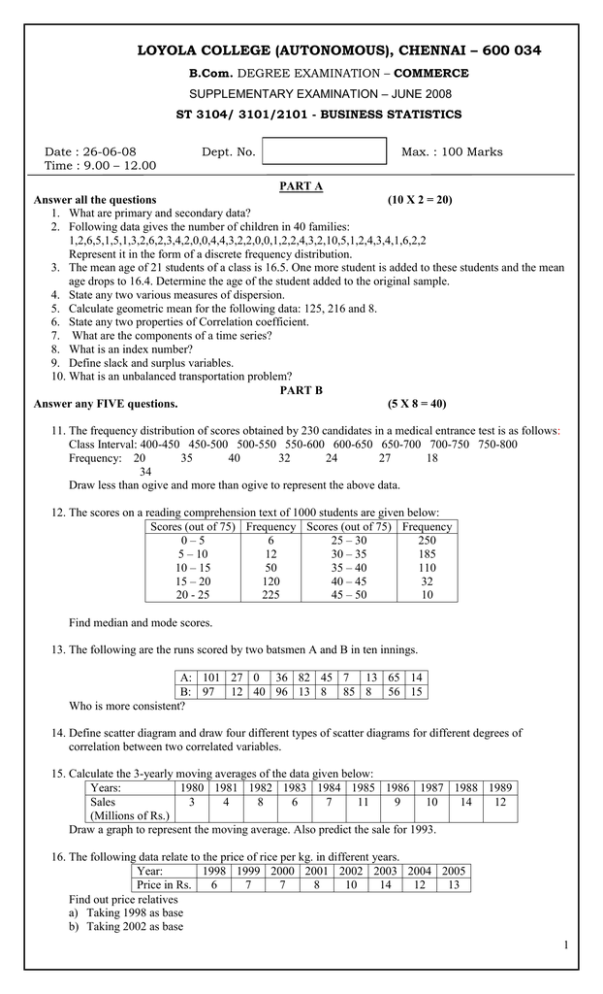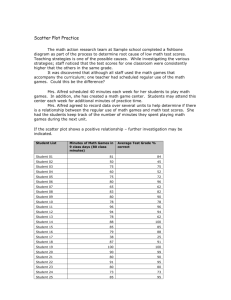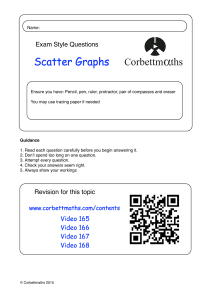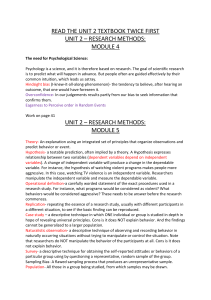LOYOLA COLLEGE (AUTONOMOUS), CHENNAI – 600 034
advertisement

LOYOLA COLLEGE (AUTONOMOUS), CHENNAI – 600 034 B.Com. DEGREE EXAMINATION – COMMERCE SUPPLEMENTARY EXAMINATION – JUNE 2008 ST 3104/ 3101/2101 - BUSINESS STATISTICS Date : 26-06-08 Time : 9.00 – 12.00 Dept. No. Max. : 100 Marks PART A Answer all the questions (10 X 2 = 20) 1. What are primary and secondary data? 2. Following data gives the number of children in 40 families: 1,2,6,5,1,5,1,3,2,6,2,3,4,2,0,0,4,4,3,2,2,0,0,1,2,2,4,3,2,10,5,1,2,4,3,4,1,6,2,2 Represent it in the form of a discrete frequency distribution. 3. The mean age of 21 students of a class is 16.5. One more student is added to these students and the mean age drops to 16.4. Determine the age of the student added to the original sample. 4. State any two various measures of dispersion. 5. Calculate geometric mean for the following data: 125, 216 and 8. 6. State any two properties of Correlation coefficient. 7. What are the components of a time series? 8. What is an index number? 9. Define slack and surplus variables. 10. What is an unbalanced transportation problem? PART B Answer any FIVE questions. (5 X 8 = 40) 11. The frequency distribution of scores obtained by 230 candidates in a medical entrance test is as follows: Class Interval: 400-450 450-500 500-550 550-600 600-650 650-700 700-750 750-800 Frequency: 20 35 40 32 24 27 18 34 Draw less than ogive and more than ogive to represent the above data. 12. The scores on a reading comprehension text of 1000 students are given below: Scores (out of 75) Frequency Scores (out of 75) Frequency 0–5 6 25 – 30 250 5 – 10 12 30 – 35 185 10 – 15 50 35 – 40 110 15 – 20 120 40 – 45 32 20 - 25 225 45 – 50 10 Find median and mode scores. 13. The following are the runs scored by two batsmen A and B in ten innings. A: 101 27 0 36 82 45 7 13 65 14 B: 97 12 40 96 13 8 85 8 56 15 Who is more consistent? 14. Define scatter diagram and draw four different types of scatter diagrams for different degrees of correlation between two correlated variables. 15. Calculate the 3-yearly moving averages of the data given below: Years: 1980 1981 1982 1983 1984 1985 1986 1987 1988 1989 Sales 3 4 8 6 7 11 9 10 14 12 (Millions of Rs.) Draw a graph to represent the moving average. Also predict the sale for 1993. 16. The following data relate to the price of rice per kg. in different years. Year: 1998 1999 2000 2001 2002 2003 2004 2005 Price in Rs. 6 7 7 8 10 14 12 13 Find out price relatives a) Taking 1998 as base b) Taking 2002 as base 1 17. A company is spending Rs. 1000 on transportation of its units from three plants to four distribution centres. The supply and demand of units, with unity cost of transportation are given as: Distribution center Plant P1 P2 P3 D1 D2 D3 D4 19 70 40 30 30 10 50 40 60 12 60 20 Availability 7 10 18 Requirements 5 8 7 15 Find basic feasible solution by using Vogel’s approximation method 18. Five different machines can do any of the five required jobs, with different profits resulting from each assignment as shown in the adjoining table. Find out maximum profit possible through optimal assignment. Machine Job A B C D E 1 30 37 40 28 40 2 40 24 27 21 36 3 40 32 33 30 35 4 25 38 40 36 36 5 29 62 41 34 39 PART C Answer any TWO questions. (2 X 20 = 40) 19. Explain different types of diagrams and graphs with an illustration. 20. A sales manager has collected the following data on annual sales and years of experience. Salesperson Years of Experience Annual Sales ($10000) 1 1 0.8 2 3 0.97 3 4 0.92 4 4 1.02 5 6 1.03 6 8 1.11 7 10 1.19 8 10 1.23 9 11 1.17 10 13 1.36 a) Develop a scatter diagram for these data with years of experience as the independent variable. b) Use the estimated regression equation to predict annual sales for a salesperson with 9 years of experience. c) Determine the co-efficient of Correlation between years of experience and annual sales turnover. 21. From the following data calculate seasonal index by the method of ratio-to-trend. Year 2001 2002 2003 2004 Quarter I 30 45 35 75 II 49 50 62 79 III 50 61 60 65 IV 35 20 25 70 22. Solve the following Linear Programming problem using simplex method: Max. Z = 3x1 + 2x2 + 5x3 Subject to x1 + 2x2 + x3 430 3x1 + 2x3 460 x1 + 4x3 420 x1, x2 , x3 0 **************** **************** 2





